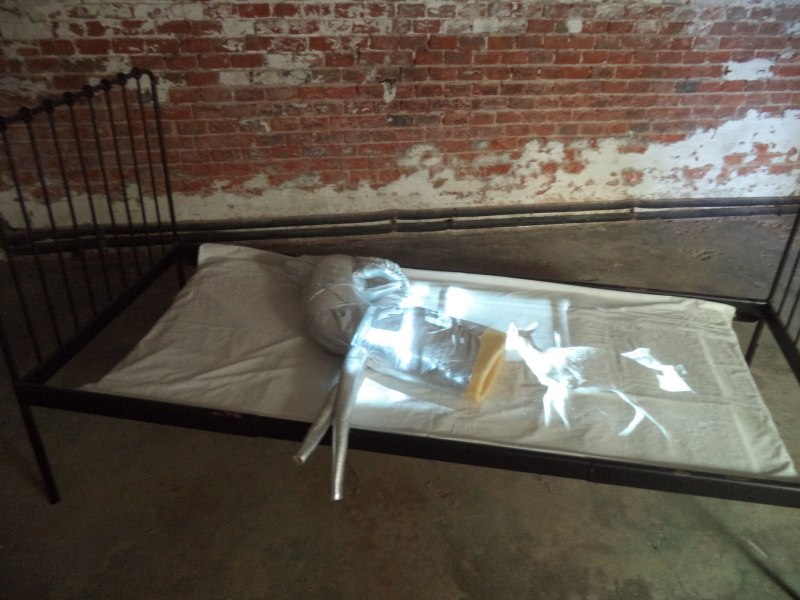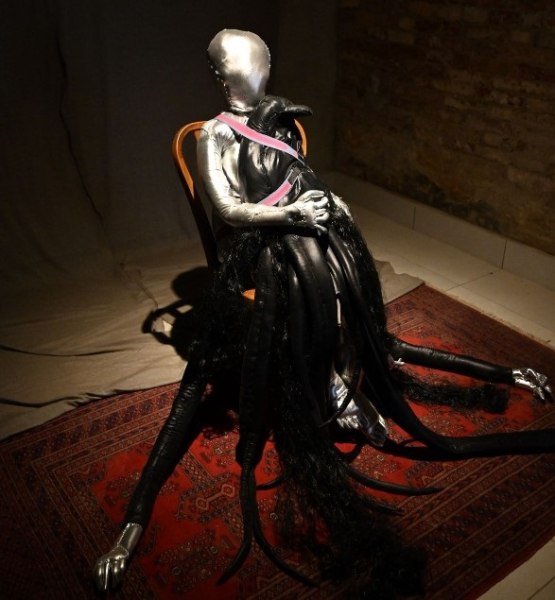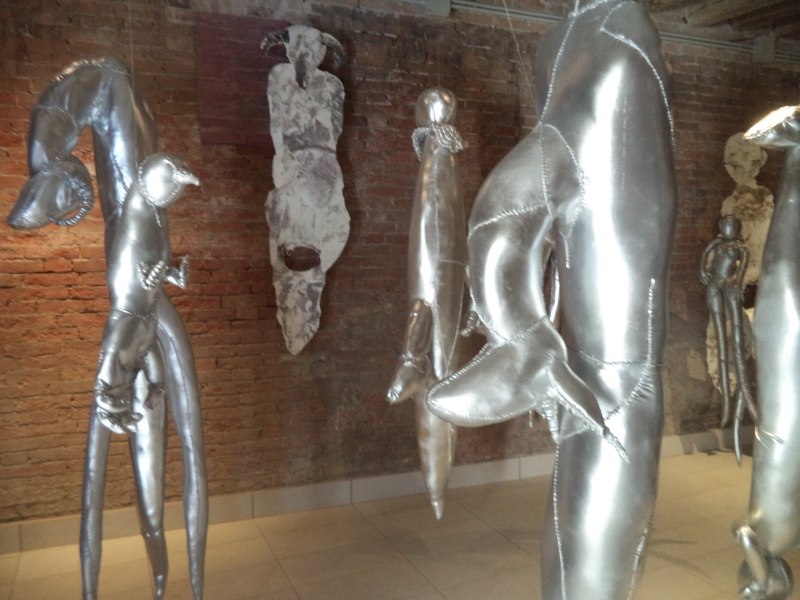Alla Biennale di Venezia, si può visitare il Padiglione Nazionale della Mongolia, con le installazioni dell’artista Munkhtsetseg Jalkhaajav. Esteticamente, a lei interessano le dialettiche della paura e della rinascita, o del dolore e della guarigione. Tramite quelle, l’anima umana può albergare in un regno. I sentimenti richiedono l’allungamento del tempo; ma quanto la loro storia si farà raccontabile? Una sceneggiatura “svelata” dall’interiorità avrà la scenografia “fatata” alla corporeità. Nessuno gradisce che gli si “smitizzino” i sentimenti… Anzi sembra normale rivendicarne l’impossibilità d’una descrizione, agli altri. Quando l’interiorità “alberga” nel tempo, la percezione “regna” nella corporeità. La lunghezza dei sentimenti “racconta” l’intensificazione del vissuto. Attraverso l’immaterialità, a farsi “romanzare” saranno soprattutto il blocco nella paura ed il flusso d’una rinascita. Le “radici” dell’anima si percepiranno fantastiche, ad intensificare di spirito la fisiologia del sistema nervoso.
A Munkhtsetseg Jalkhaajav interessa prettamente la figura femminile. C’è il “mistero” antropologico della Grande Madre. Nascendo, il bambino albergherebbe nel “regno” d’un grembo familiare. La psicanalisi ci ricorda gli archetipi, i quali si tramandano affinché la generazione evolva. L’artista s’ispira anche ai metodi fai da te di guarigione, nella tradizione mongola. Di conseguenza, la mitologia fantastica si praticherà nel rituale. Il guaritore prova ad incarnare un sentimento, e raccontandone al massimo una simbologia. All’artista interessa molto la pulsazione vitale. Qualcosa che permetta al corpo “d’albergare” in una rinascita costante. Se appaiono alcuni tagli, nella rappresentazione estetica, favorevolmente quelli potrebbero “nascondere” lo sforzo spirituale d’una cura, e dai loro amuleti. Più in generale, l’anima è sempre protettiva. Essa ha lo “scudo” d’un regno, rappresentando l’interezza d’una persona, fra il corpo e la mente. La donna in aggiunta ha il privilegio della maternità, per manifestare l’incarnazione d’un sentimento perenne, in quanto responsabilizzata verso il figlio.
Per Bronislaw Malinowski, la magia segue una duplice regola. Dapprima si percepisce la simpatia. Il mago dev’essere in qualche modo simile all’oggetto su cui vuole intervenire. Quindi subentra la contiguità. Se il mago provoca una mera parte di qualcosa, alla fine tutta questa ne risentirà. Fenomenologicamente la simpatia “alberga” nella cura per la somiglianza esteriore, mentre la contiguità “regna” nel mondo dall’interconnessione automatica.
A Venezia, Munkhtsetseg Jalkhaajav ha rivisitato l’ambientazione del fienile. Fra le pareti ed il pavimento scrostato, le installazioni si percepiscono in un tentativo d’imbottire gli arti del corpo umano. Il risultato finale è fantasticamente bucolico. Pare che il tronco d’un albero acquisisca le ali d’uccello. Le fronde e le piume, in rappresentanza dell’altro mondo (dai vegetali agli animali), avrebbero la secchezza del fieno in una trasfigurazione nervosa, mentre il respiro diventa “intellettualmente argentato”. Nell’installazione dal titolo Dream of gazelle: healing bed, la trapunta sarebbe stata appesa come un sudario. L’organo interno si rivela, in un totem che preannuncia un preformismo embrionale, dal crash test placentare d’uno spermatozoo “a manichino”. Nella trapunta si percepisce il tono eccitato della morbidezza, grazie all’argento. Sul letto, giace una gazzella dal corpo tagliato a metà. Con la trapunta rimossa, rendendo l’eventuale cura in balia del freddo, sarebbe il sogno a conferire l’igiene dell’anestesia. Realisticamente, una videoproiezione “carica” sul corpo tagliato il preformismo d’una giovane gazzella. Simbolicamente, sembra che l’interconnessione col mondo chieda d’aver provocato un “rito iniziatico”, per la mente incarnatasi dall’estasi all’empatia. Il fascio di luce è “intellettualmente” trasparente. Ma la maternità accetta di “sacrificare” il pensiero distaccato, in favore del sentimento costante.
Nell’installazione denominata Pulse of life, l’artista prova a rappresentarci una corporeità dal riassemblaggio cosmico. Si tratta di rendere “fatato” il manichino, mentre il “cappio” del Destino tira l’esistenza, predeterminandone l’adattamento “abortito” con l’Alterità. Sognando, i pensieri si giustapporrebbero assieme, “ovattando” ogni dialettica fra l’istinto per l’emozione e la razionalizzazione d’una comprensione. Parallelamente alla mente, il corpo potrebbe “regnare” sul serio solo mediante lo zoomorfismo. La tradizione filosofica in Occidente ha preferito che l’anima s’astraesse in modo più “freddo”: dal coinvolgimento per il sentimento alla razionalità “di blocco”. La tecnologia umana sviluppa il metallo, “annichilendo” l’empatia della roccia (mentre l’incastro cede alla decantazione). Diversamente, il guaritore “rurale” desidera un “ribollimento” degli elementi. Forse il realismo razionalizzato funziona come un “morbido” palliativo, mentre è l’interiorità sentimentale che “tira incisivamente le redini” della vitalità, nonostante la fatalità della caducità. Dunque lo zoomorfismo dell’artista ci simboleggia una “ritualità” dell’anima, a “riassemblare” il senso dell’esistenza.
Nell’installazione dal titolo Miscarriage: keeper of protector bird, la donna avrebbe un grembo innaturale, con la placenta di penne. Come al solito, tutto ruota intorno alla sacralità della vita. La grazia dell’uccello riuscirà a proteggere la donna, dalla fuggevolezza d’un aborto spontaneo. Simbolicamente, il samsara sarebbe stato intercettato e diretto da uno sciamano. La vita chiede l’interconnessione fra la nascita e la morte. Le penne dell’uccello riuscirebbero ad “incantare” i nervi della donna. Non si partorisce mai in rilassatezza… Anzi pare che l’avvinghiarsi sessuale liberi, assieme al respiro argentato, un sangue nero. Le penne dell’uccello sono percepibili anche in via venosa, complice la forma tubolare. L’argento può sembrare la tonalità del fai da te, “raffreddando” l’animo sul tentativo di governare, intellettualmente, le situazioni di vita. Nel parto, ci si augura sempre il “sospiro” di sollievo materno, al primo vagito del neonato. Qualcosa che la “grondaia” della placenta dovrà scaricare, avendo vinto il nero della morte.
THE ZOOMORPHISM OF THE DREAM IS THE “HEALER” OF THE SOUL
At the Venice Biennale, we can visit the National Pavilion of Mongolia, with the installations of the artist Munkhtsetseg Jalkhaajav. Aesthetically, she is interested in the dialectics of fear and rebirth. Through those, the human soul can lodge at a kingdom. The feelings request the prolongation of the time; but how much will their story able to be told? A screenplay “unveiled” by the inwardness will have the scenography “fairy” at the corporeality. Nobody likes that his feelings are “debunked”… On the contrary, it seems normal that we claim their impossibility to be described, in favour of the others. When the inwardness “lodges” in the time, the perception “reigns” in the corporeality. The length of the feelings “tells” the intensification of the living. Through the immateriality, principally a block in the fear and the flow of a rebirth will allow their “romanticization”. The “roots” of the soul will be perceived in fantastic way, to intensify, by the spirit, the physiology of the nervous system.
Munkhtsetseg Jalkhaajav is principally interested in the female figure. There is the anthropological “mystery” of the Great Mother. Being born, the child would lodge in the “kingdom” of a family womb. The psychoanalysis reminds us of the archetypes, which are bequeathed for the evolution of a generation. The artist is also inspired by the do-it-yourself technique about the healing, in the Mongolian tradition. Consequently, the fantastic mythology will be practised through a ritual. The healer tries to incarnate a feeling, and telling at most its symbology. The artist is very interested in the vital pulse. Something that allows the body “to lodge” in a constant rebirth. If some cuts appear, in the aesthetic representation, favourably those could “hide” the spiritual effort of a therapy, and from their amulets. More in general, the soul is always protective. It has the “shield” of a kingdom, representing the wholeness of a person, between the body and the mind. In addition the woman has the privilege of the maternity, to show the incarnation of a perennial feeling, because she is responsible for the child.
According to Bronislaw Malinowski, the magic is based on two principles. At the beginning we perceive the sympathy. A magician has to be roughly similar to the object where he wants to intervene. Consequently, the contiguity comes. If a magician provokes a part of something, that thing finally will feel an effect in all its parts. Phenomenologically the sympathy “lodges” in the care for the external similarity, while the contiguity “reigns” in a world with the automatic interconnection.
In Venice, Munkhtsetseg Jalkhaajav reexamined the setting of a barn. Between the walls and the floor, both of them scraped off, the installations are perceived in the effort of stuffing the limbs of the human body. The final result is fantastically bucolic. It seems that the log of a tree acquires the wings of a bird. The leaflets and the feathers, on behalf of the other world (from the vegetables to the animals), would have the dryness of the hay in a nervous transfiguration, while the breath becomes “intellectually silver-plated”. In the installation called Dream of gazelle: healing bed, the quilt would have been hung like a shroud. The internal organ shows itself, in a totem pole that forebodes an embryonic preformationism, from the placental crash test of a spermatozoon “as a dummy”. In the quilt we perceive the excited tone of the softness, through the silver. On the bed, a gazelle with the body cut in half lies. With the removed quilt, allowing the potential therapy to be at the mercy of the cold, the dream would be able to confer the hygiene of an anesthesia. Realistically, a video-projection “loads” into the cut body the preformationism of a young gazelle. Symbolically, it seems that the interconnection with the world requests to have provoked an “initiation rite”, for the mind that incarnated itself from the ecstasy to the empathy. The light beam is “intellectually” transparent. However the maternity accepts to “sacrifice” the detached thought, in favour of a constant feeling.
In the installation called Pulse of life, the artist tries to show us a corporeality with a cosmic reassembly. In this case the dummy needs to be “fairy”, while a “noose” of the Destiny pulls the existence, predetermining its “aborted” adjustment with the Alterity. In a dream, the thoughts are juxtaposed together, in the “wadding” for every dialectics between the instinct for an emotion and the rationalization of a comprehension. In parallel with the mind, the body could really “reign” only through a zoomorphism. The philosophical tradition in the West preferred that the soul abstracted itself in a “colder” way: from the involvement of a feeling to the “blocking” rationality. The human technology develops the metal, “annihilating” the empathy of the rock (while the joint cedes to the decantation). Differently, the “rural” healer desires a “bubbling” of the elements. Perhaps the rationalized realism functions as a “soft” palliative, while the sentimental inwardness is able to “pull incisively the reins” of the vitality, in spite of the fate of the caducity. So the zoomorphism of the artist symbolizes to us a “ritual” of the soul, to “reassemble” the sense of the existence.
In the installation called Miscarriage: keeper of protector bird, the woman would have an unnatural womb, with the placenta of feathers. As usual, everything revolves around the sacredness of the life. The gracefulness of the bird will be able to protect the woman, from the fleetingness of a miscarriage. Symbolically, the samsara would have been intercepted and directed by a shaman. The life requests an interconnection between the birth and the death. The feathers of the bird would be able to “enchant” the nerves of the woman. It is impossible to give birth in relaxation… Rather it seems that the clinging sex releases, together with the silver-plated breath, a black blood. The feathers of the bird are perceived also in a venous way, with the complicity of a tubular shape. The silver can seem the tone of the do-it-yourself, “cooling” the soul on the attempt through which we govern, intellectually, the life situations. In the childbirth, always we wish a maternal “sigh” of relief, at the first wail of the infant. Something that the “gutter” of the placenta will have to drain, after it defeated the black of the death.






